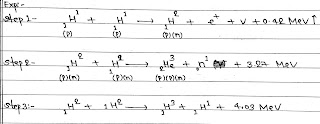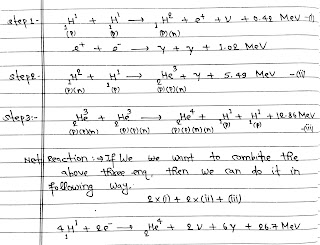Nuclear Fusion:
The process in which two light nuclei combine(at extremely high temperature) to form a single heavier nucleus is called nuclear fusion.
For Fusion to take place, the two nuclei must come close enough so that attractive short range nuclear force is unable to affect them. Since both the nuclei are positively charged particles, so they experience coulombs repulsion. Therefore, they must have enough energy to overcome this coulomb barrier.
Fusion of hydrogen nuclei into helium nuclei is the source of energy of most of the stars including the sun.
Energy Generation in Stars:
The fusion reaction in the sun is a multi-step process in which the hydrogen is fused into helium. The proton- proton(P,P) cycle by which this occurs is represented by the following reactions.
Controlled Thermonuclear Fusion:


